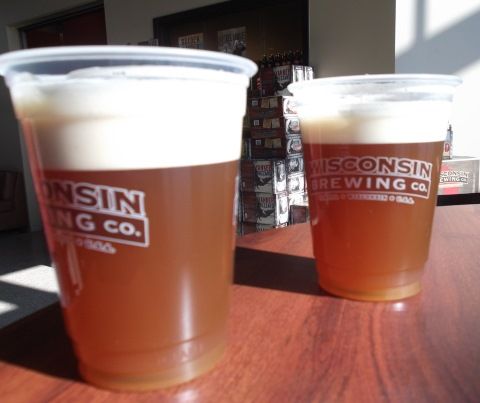
Last Thursday Wisconsin Brewing Company offered a relative rarity on tap – an Extra Special Bitter. It was part of their Forward series which introduces small batches to drinkers and then solicits their feedback. I suppose it also allows the brewers to try their hand at something different - a new ingredient, perhaps, or a style which wouldn't warrant massive quantities.
I headed down to Verona with a friend who had lived in London for a year where he acquired a taste for English mild ales, bitter, and the ESB. He's fond of the ESB at The Great Dane downtown but, overall, doesn't get to indulge his taste for English real ales too often here in the land of the IPA. We were both a little apprehensive as the e-mail invite described the beer as having "a focus on bittering hops" which we thought may be their way of saying that it's really an India Extra Special Bitter Pale Ale. My friend quipped that he wanted something warm (well, cellar temp), flat (natural carbonation), and malty.
I've read quite a bit less about English beer styles than I have those from other countries and drank less of them too. (I have reviewed one ESB prior to this: ESB Amber from Saugatuck Brewing.) From what I gather, the ESB is a stronger and more full-bodied bitter. And a bitter, contrary to its name, is all about the malt. Your ordinary bitter is a true session beer, usually under 4% A.B.V. They have a healthy malt taste along with a fair amount of hops for balance. And so the ESB is the bigger cousin of the bitter. More maltiness, more hoppiness, and more alcohol. But this no imperial mega-quad that can fuel jet planes. We're talking more along the lines of 5%.
WBC's ESB is (or perhaps was, by now) 4.7% A.B.V. and 33 I.B.U. which perhaps comes in at the low end of ESB spectrum. My companion seems to have mistaken the ESB for the ordinary bitter as he felt the alcohol content was too high here. The beer was offered both on cask - served via a beer engine - and keg - your normal keg with gas pumped into it. The difference between the two is that a beer engine has a piston which goes up and siphons the beer out of the cask while your more familiar tap sees gas pumped into the keg which pressurizes it. Open the tap and the high pressure flows to the low.
We, of course, went with the brew from the cask. The beer was copper in hue, perhaps with a slight orange tint, and very turbid. I have to admit that I don't know if an ESB should be clear or not. My glass came topped with a big white head that lasted a good long time. I couldn't see any bubbles inside the beer.
The aroma was wonderful. There was some expected caramel as well as toasted grain. The great part was that it smelled like a brewery. That grainy smell that greets your nose when you walk into a brewhouse – that's what this ESB smelled like, in the main. Although the hops couldn't compare to the malt, they were not exactly slouches. Here I smelled floral/grassy hops with perhaps just a touch of citrus in the background. At this point we were convinced that this wasn't some kind of Americanized take on the venerable English style where it was dry hopped with Cascade and then aged on a bed of Citra inside a bourbon barrel with brett.
It was hard not to notice the relatively warm temperature the beer was served at. Quite a change of pace after having quaffed a bunch of pilsners recently. Similarly the rather low carbonation also stuck out to me. Just like the aroma, the taste had an emphasis on the malts with toffee and plum flavors lending a touch of sweetness but there was also a distinctly less toothsome biscuit flavor as well. WBC did not reveal any ingredients to use proles but the hops tasted like what I think of as being classically English – very grassy. They were quite tasty and kept the malt sweetness in check.
Those malty flavors faded quickly at the end allowing the hops to take on a slightly more intense straw taste and increase the bitterness as well which left my tongue rather dry. ESB left some really nice lacing inside my glass (plastic). There were streaks, patches, spots – the whole nine yards.
While I cannot compare WBC's take on the ESB to something I'd find at a pub in England, I really enjoyed it nonetheless. It had a light-medium body with a definite emphasis on the malts but it was not overly sweet. I don't know if WBC used traditional English hops like Fuggles or East Kent Goldings or the nearest equivalent. Regardless, the grass and straw hop flavors were wonderful and a welcome change from the spicier Noble flavors I've had recently. With the trend leaning towards tropical fruit tasting hops, these kinds of flavors are often lost in the shuffle. While by no means a big beer, it was not short on taste. But it wasn't about bullying your tongue. Rather, it gently plied it with malts and then some grassy hop bitterness to balance things out. Easy to drink more than one.
Junk food pairing: Crisps! Eat potato chips with your WBC ESB, especially the ones with weird flavors – those Lay's chips that were crowd-sourced. The current batch has gyros, reuben, and biscuits & gravy.
No comments:
Post a Comment